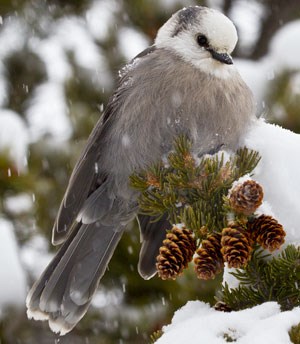
NPS/Ann Schonlau Perisoreus canadensisLength:11-12.25 in. (27.5 - 30.5 cm) - Weight:2.5 ounces (70 grams) General DescriptionGray Jays are medium-sized, gray birds with lighter bellies. Gray Jays are stocky, fairly large songbirds with short, stout bills. They have round heads and long tails, with broad, rounded wings. Gray Jays are dark gray above and light gray below, with black on the back of the head forming a partial hood. Juveniles are grayish black overall, and usually show a pale gape at the base of the bill. HabitatGray Jays live in mixed evergreen-deciduous forest across the boreal forest of the United States and Canada. The Gray Jay makes its home in boreal and subalpine forests across northern North America, usually where black or white spruce trees are common. Other tree species often found in its habitat include aspen, white birch, balsam fir, sugar maple, lodgepole pine, jack pine, red spruce, Engelmann spruce, Sitka spruce, eastern white cedar, yellow cedar, alpine fir, amabilis fir, and mountain hemlock. BehaviorGray Jays are typically in small groups. They have a wide variety of vocalizations including hoots and chatters. The Gray Jay usually flies slowly, gliding with its wings angled downward, but it is capable of fast, maneuverable flight when escaping a predator or disputing territory with another jay. They stay with their mates as long as both birds are alive, and the members of a territorial pair rarely leave each other's sides. The pair breeds in frigid conditions during February and March. In June, the biggest member of the brood kicks its siblings out of the parents' territory, which it then uses as a safe haven until a nearby territory becomes available. The displaced siblings go looking for unrelated adult pairs whose own nests have failed, in the hopes of adopting their own safe havens. If a young bird is still hanging around the following year, the breeding pair prevents it from approaching the nest-but the young bird may help feed the new chicks once they fledge. Gray Jays use alarm calls, chattering, screaming, and mobbing when hawks, owls, or crows approach. They tend to be fearless of humans, particularly when human food is involved. They can be very bold and will beg from campers, follow hikers, and go inside cabins to steal food. DietGray Jays eat a variety of foods including arthropods, berries, carrion, nestling birds, and fungi. They learn quickly to recognize and look for human food, as well as take advantage of game that has been shot or trapped by hunters. When foraging, the Gray Jay scans its surroundings from a succession of perches, each a short flight apart from one another. It will snap up flying insects in the air, wade in shallow water to capture invertebrates and amphibians, kill small mammals, raid the nests of other birds, and occasionally pursue small birds like chickadees and warblers. They store food year-round by producing special saliva from large glands and molding the food into a sticky blob, gluing it behind flakes of bark, under lichen, in conifer needles, or in tree forks. They seem to have a good success rate of remembering where they have stored food. NestingThe male chooses the site after perching and looking around in several suitable spots. He picks a site at low to moderate height, often choosing a tree close to the south-facing edge of a forest patch to take advantage of the extra warmth from sunlight. Both sexes do the same nest-building activities, but the male does most of the work during the early stages. He starts by making a loose ball of spruce and tamarack twigs and holding it together with cocoons from forest tent caterpillars. Then he and his mate add a donut of twigs above the ball, filling it in with finer twigs, bark strips, and lichens. They line the cup with feathers or fur and mold it by pressing their bodies inside of it. The female helps more and more throughout the 3-week process, and by the end she may be contributing more than the male. The finished nest is 4 to 6 inches high, with a cup about 2 inches deep and 3 inches across. Eggs & IncubationGray Jays are monogamous, and pairs stay together on their territories year round. Their eggs are gray-white with little to no markings. The male brings food to the nest while the female incubates two to five eggs for about 18 days. The female broods the young for about four days, and then joins the male in feeding the young. The young leave the nest at 22 to 24 days, but stay with their parents for another four to six weeks. Recent studies have shown there to be a third, unrelated bird on the territory, helping throughout the nesting season. Migration StatusGray Jays do not migrate, but will sometimes move down in elevation during the winter months. Interesting Facts
|
Last updated: May 4, 2018
